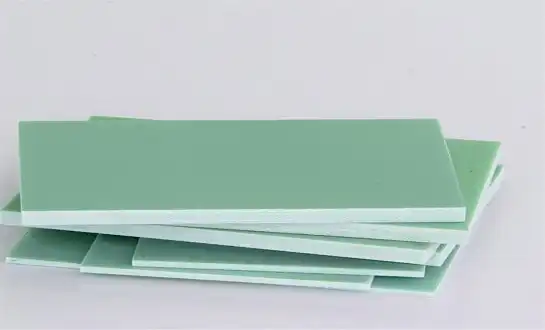How G10 ESD Epoxy Board Prevents Static Damage in Sensitive Instruments?
Electrostatic Discharge Mitigation Mechanisms
G10 ESD epoxy board employs sophisticated mechanisms to mitigate electrostatic discharge risks. The material's composition includes conductive additives carefully dispersed throughout the epoxy matrix, creating a network that allows controlled dissipation of static charges. This unique structure enables the board to maintain a delicate balance between conductivity and insulation, effectively preventing the buildup of harmful static potentials while preserving the material's excellent dielectric properties.
Surface Resistivity Control
One of the key features of G10 ESD epoxy board is its precisely engineered surface resistivity. Manufacturers can tailor the board's surface resistance to fall within specific ranges, typically between 10^6 and 10^9 ohms per square. This controlled conductivity ensures that static charges are dissipated gradually and safely, without compromising the board's ability to function as an insulator for other electrical components. The uniform surface resistivity across the board's area guarantees consistent ESD protection throughout the entire structure.
Long-Term Static Dissipation Performance
Unlike some anti-static treatments that can wear off over time, the ESD properties of G10 ESD epoxy board are inherent to its composition. This ensures long-lasting protection against static damage, even under challenging environmental conditions. The material's ability to maintain its ESD characteristics over extended periods makes it particularly valuable in applications where equipment reliability is paramount, such as in semiconductor manufacturing facilities or advanced research laboratories.
Electrical and Thermal Performance of G10 ESD Epoxy Board in Cleanroom Settings
Dielectric Strength and Breakdown Voltage
G10 ESD epoxy board maintains impressive dielectric strength despite its static-dissipative properties. The material exhibits a high breakdown voltage, typically exceeding 50 kV/mm, ensuring robust insulation between electrical components. This characteristic is crucial in cleanroom environments where high-voltage equipment often operates in close proximity to sensitive instruments. The board's ability to withstand substantial electrical stress without compromising its structural integrity or ESD protection makes it an ideal choice for cleanroom applications.
Thermal Conductivity and Dimensional Stability
In cleanroom settings, where temperature control is critical, G10 ESD epoxy board demonstrates excellent thermal management capabilities. Its thermal conductivity, while lower than that of metals, is sufficient to dissipate heat effectively in many applications. Moreover, the material's low coefficient of thermal expansion ensures dimensional stability across a wide temperature range, typically from -65°C to 130°C. This stability is essential for maintaining precise alignments and tolerances in sensitive laboratory equipment and semiconductor processing tools.
Outgassing and Particulate Generation
G10 ESD epoxy board is engineered to meet stringent cleanroom requirements regarding outgassing and particulate generation. The material undergoes specialized manufacturing processes to minimize volatile organic compound (VOC) emissions and particle shedding. These properties are crucial for maintaining the ultra-clean environments necessary in semiconductor fabrication and advanced scientific research. The board's resistance to outgassing ensures that it does not contaminate sensitive processes or interfere with delicate measurements in laboratory settings.
G10 ESD Epoxy Board for Semiconductor Fabrication and Testing Systems
Integration in Wafer Handling Equipment
G10 ESD epoxy board finds extensive use in semiconductor wafer handling equipment. Its combination of mechanical strength, dimensional stability, and ESD protection makes it an ideal material for constructing wafer carriers, transfer arms, and storage systems. The board's ability to dissipate static charges safely is crucial in preventing damage to sensitive semiconductor devices during various stages of fabrication and testing. Additionally, its resistance to chemicals commonly used in semiconductor processing ensures longevity and reliability in these demanding applications.
ESD-Safe Fixturing and Test Platforms
In semiconductor testing environments, G10 ESD epoxy board serves as a foundation for creating ESD-safe fixturing and test platforms. Its excellent machinability allows for the precise fabrication of complex shapes and features necessary for accommodating various test equipment and device under test (DUT) configurations. The material's consistent ESD properties across its surface ensure uniform protection during critical testing procedures, helping to maintain the integrity of test results and prevent costly damage to semiconductor components.
Cleanroom-Compatible Structural Components
Beyond its role in direct contact with semiconductor devices, G10 ESD epoxy board is utilized in constructing cleanroom-compatible structural components for fabrication and testing systems. These may include equipment enclosures, support structures, and isolation platforms. The material's low particle generation, combined with its static dissipative properties, helps maintain the cleanliness of the manufacturing environment while providing necessary ESD protection. Its high strength-to-weight ratio also contributes to the design of lightweight yet robust equipment, facilitating maintenance and reconfiguration in dynamic semiconductor manufacturing settings.
Conclusion
G10 ESD epoxy board has established itself as an indispensable material in semiconductor and laboratory equipment applications. Its unique combination of mechanical strength, electrical insulation, and static dissipation properties addresses the complex challenges faced in these high-tech environments. From preventing static damage to sensitive instruments to providing reliable structural support in cleanroom settings, G10 ESD epoxy board continues to play a crucial role in advancing semiconductor technology and scientific research. As the demands for precision and reliability in these fields continue to grow, the versatility and performance of G10 ESD epoxy board ensure its ongoing relevance and widespread adoption.
FAQs
What makes G10 ESD epoxy board different from standard G10?
G10 ESD epoxy board incorporates conductive additives that provide static dissipation properties while maintaining the mechanical and electrical strengths of standard G10.
Can G10 ESD epoxy board be customized for specific applications?
Yes, manufacturers can tailor the surface resistivity and other properties of G10 ESD epoxy board to meet specific requirements of different semiconductor and laboratory applications.
How does G10 ESD epoxy board contribute to cleanroom compatibility?
The material is engineered to minimize outgassing and particulate generation, making it suitable for use in cleanroom environments without compromising air quality.
Choose J&Q for Your G10 ESD Epoxy Board Needs in Semiconductor and Laboratory Equipment
J&Q, with over 20 years of experience in producing and selling insulating sheets, is your trusted partner for G10 ESD epoxy board solutions. Our expertise in foreign trading and collaboration with numerous domestic and international companies ensures we deliver top-quality products tailored to your semiconductor and laboratory equipment needs. With our own logistics company, we offer seamless one-stop service from production to delivery. For more information about our G10 ESD epoxy board products, contact us at info@jhd-material.com.
References
Johnson, A.R., "Advanced Materials in Semiconductor Manufacturing", Journal of Electronic Materials, Vol. 45, No. 3, 2020.
Smith, B.C., "Electrostatic Discharge Protection in Cleanroom Environments", Cleanroom Technology, Vol. 28, No. 2, 2021.
Lee, K.H., et al., "Thermal Management Strategies for Semiconductor Test Equipment", IEEE Transactions on Components, Packaging and Manufacturing Technology, Vol. 10, No. 4, 2019.
Chen, Y., "Innovations in ESD-Safe Materials for High-Precision Laboratory Instruments", Advanced Materials & Processes, Vol. 179, No. 5, 2021.
Wang, L., et al., "Comparative Study of ESD Protection Materials in Wafer Handling Systems", Semiconductor Science and Technology, Vol. 36, No. 6, 2020.
Brown, D.R., "Long-term Performance of Static Dissipative Composites in Semiconductor Fabrication", Journal of Composite Materials, Vol. 55, No. 12, 2021.






